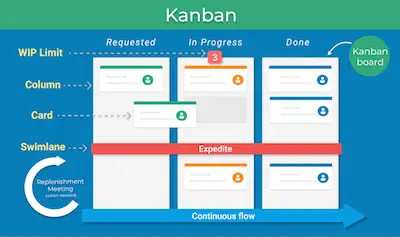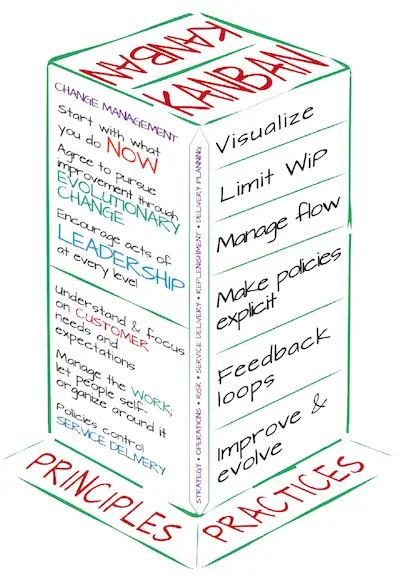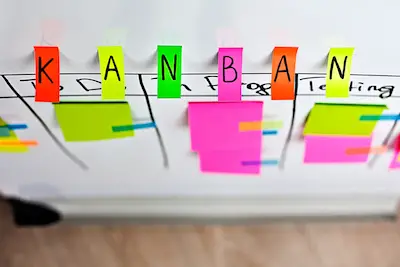When you are looking for a good way to improve systems within your organization, then you should consider Kanban methodology agile.
Simply put, and according to David J, Anderson, the Kanban method is an approach to evolutionary and incremental process and systems change for organizations. While this may seem a bit complicated, it really isn’t. The truth is that Kanban is just a different way that you have to organize the chaos that tends to affect so many delivery teams by making the need for focus clear and prioritization. Besides, Kanban can also be described as an effective way to uncover workflow and process problems. This way, you can solve them to ensure that you can deliver more consistently to your customers.

Lara how you can focus on your customers.
In order to accomplish all these things, Kanban introduces constraints into the system to optimize the flow of value. Besides, the idea of value is crucial. After all, you may even have a great flow but if it isn’t valuable, then it isn’t worth it.
While the Kaban methodology is pretty straightforward, you need to know that there are 9 things you need to know about this methodology. These include 4 principles that refer to the way you need to think and 5 properties that refer to what you need to do.
One of the things that you need to keep in mind about Kanban is that this methodology doesn’t prescribe a specific procedure or setup. And this makes it very easy to implement and use Kanban. After all, you can simply overlay Kanban properties on top of your existing process or workflow to bring your issues to light. This will allow you to introduce positive changes over time.
Discover the visual management tools hat can benefit your office environment.
Another key principle of Kanban is that it is an approach to change management that is designed to meet minimal resistance.
Simply put, the Kanban only requires small and incremental changes to your own system. So, even if your employees tend to resist change, they shouldn’t have any problems with Kanban. This is a methodology that many people refers to as baby steps.

One of the best things about using this process is that you won’t change things immediately in just one day. In fact, the Kanban methodology takes a step further and it actually recognizes beforehand that there may be value in your current process, roles, responsibilities, and titles.
The truth is that you aren’t doing everything wrong. There are things that you’re doing the right way and others that can be improved using this methodology. Kanban doesn’t prohibit change, but it doesn’t prescribe it either. If you do make changes, Kanban encourages incremental change. Incremental change doesn’t create the level of fear that impedes progress, which allows you to generate broader support for your Kanban implementation. It also makes it easier to implement Kanban. Small course corrections are also just inherently easier than altering the complete process.
This principle is actually shared by many different methodologies nowadays. And with Kanban, you don’t need to be a team lead or an executive to be a leader.
The reality is that some of the best leadership comes from everyday acts from people on the front line of their respective teams. Everyone needs to be fostering a mindset of continual improvement (kaizen) to reach your optimal performance as a team/department/company. This can’t be a management level activity.
What is Quick Response Manufacturing (QRM)?

When you are looking for success cases where this methodology has been used, then you will discover that all of them share 5 core properties.
One of the main Kanban core properties stats that you need to completely understand the entire process. This means that you need to know what it takes to get an item from request to completion.
As you already know, the goal of Kanban in scrum is to ensure that you can make positive changes so you can optimize the flow of work through the system. So, as you can easily understand, only when you have this understanding is that you can improve it by making the right adjustments.
The reality is that when you try to make these changes before you have a good grasp of your current workflow won’t work.
One of the methods that most business owners tend to use to visualize the workflow is to use card walls with cards and columns. Each column they have on the wall represents steps in their workflow. However, it is also worth to point out that there is no one right workflow or one right way to categorize your requests. As we already mentioned above, Kanban doesn’t prescribe specific workflows. You will need to work with what you already have. And this is why you won’t probably find a workflow similar to yours. And this is perfectly normal and ok.
Another core property of the Kanban methodology is that you need to ensure that you put a limit to the wor-in-progress. And if you think about it, it makes perfect sense. After all, the critical elements are that work-in-progress at each state in the workflow is limited and that new work is “pulled” into the next step when there is available capacity within the local WIP limit. These constraints will quickly illuminate problem areas in your flow so you can identify and resolve them. Limiting WIP is the cornerstone of Kanban.
Does waste reduction really important?

The main goal of using the Kanban methodology in your organization is to create positive change. However, before you can even change something, you need to know what you need to change in the first place. And this can be done by looking at how value is currently flowing through your system. You should then analyze problem areas in which value flow is stalled, and only then define the changes. As this is done, you will then implement these same changes.
But the Kanban methodology implementation doesn’t stop here, The truth is that after you made the first change, you will need to repeat the cycle to see if the change you made had a positive impact, a negative impact or no impact at all on the things you were trying to change. And this process keeps going on and on; it never ends.
While you can follow all the principles and core properties of Kanban, unless everyone within your organization understands them, you won’t succeed.
The truth is that when you are visualizing your workflow, you need to know what is actually happening. So, you need to ensure that you define the process and that it is also published and socialized. When you don’t take the time to understand and explain how things work and how work is actually done, any problem or discussion tends to be subjective and emotional. On the other hand, when everyone understands what you are doing and your goals, then you can begin to make decisions regarding change that will move you in a positive direction. The choices will be more rational, empirical, objective discussion of issues. This is more likely to facilitate consensus around improvement suggestions.
As we already mentioned above, when you decide to implement the Kanban method, you will be introducing small, incremental, and evolutionary changes that stick. And this leads us to Kaizen.
In case you don’t know, Kaizen is a word that generally means continuous improvement. And you can easily understand that Kaizen is a key part of using Kanban effectively.
When teams have a shared understanding of theories about work, workflow, process, and risk, they are more likely to be able to build a shared comprehension of a problem and suggest improvement actions that can be agreed upon by consensus.
The Kanban method suggests that a scientific approach is used to implement continuous, incremental and evolutionary changes. There are various models that you can use, including the Lean Economic Model (based on the concepts of waste), the System of Profound Knowledge (a study of variations and how it affects processes), and the Theory of Constraints (the study of bottlenecks).
As you can see, the Kanban methodology agile is a great way to improve your processes and systems by adding positive change in small increments. This allows your staff to embrace change more positively as well.
One of the most important aspects of this methodology is that it is never complete. The truth is that there are always aspects that you can improve but with the help of Kanban principles and core properties, you will be able to change them one by one. Besides, you shouldn’t forget to keep track of the changes and the results that you get from each one.